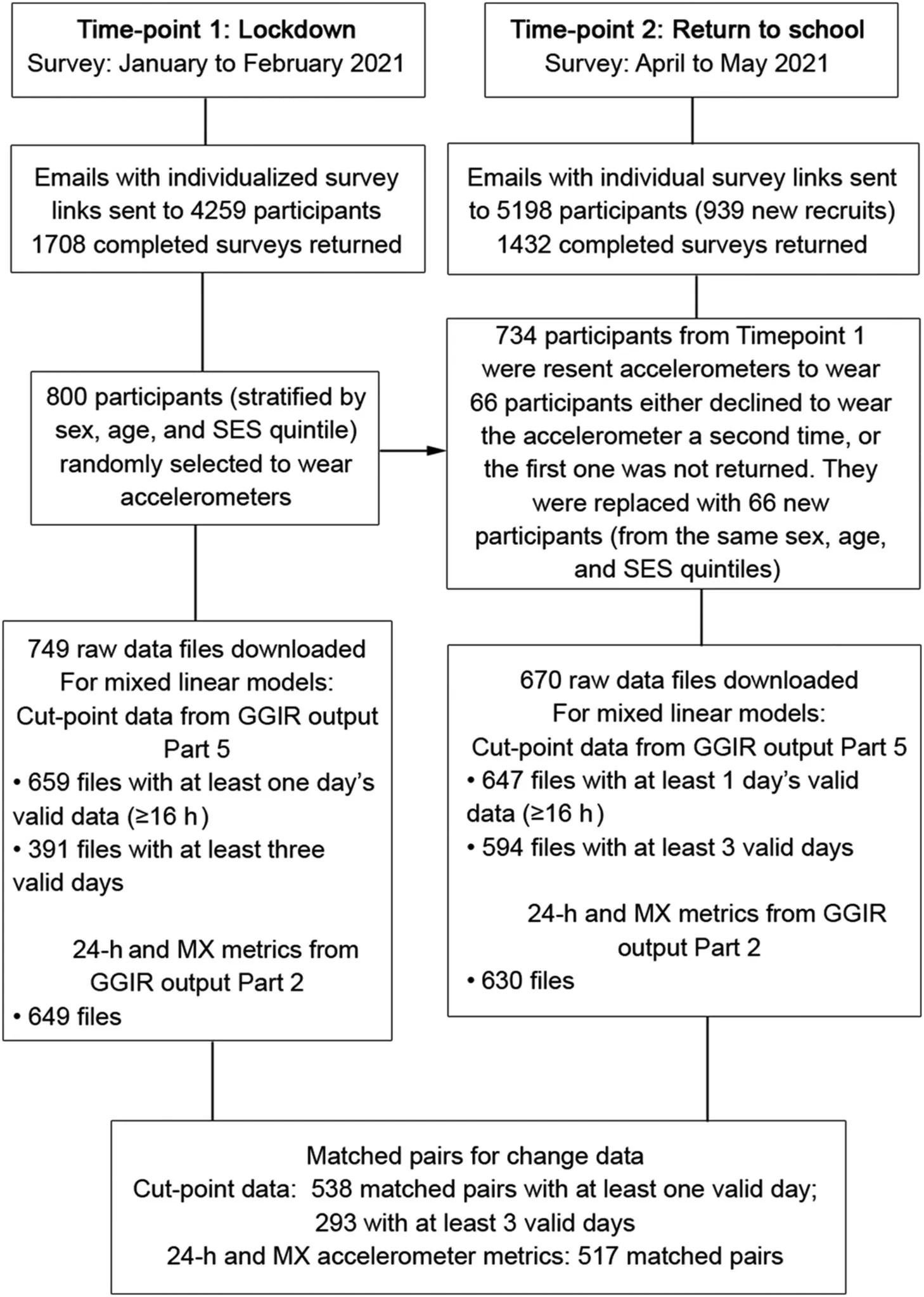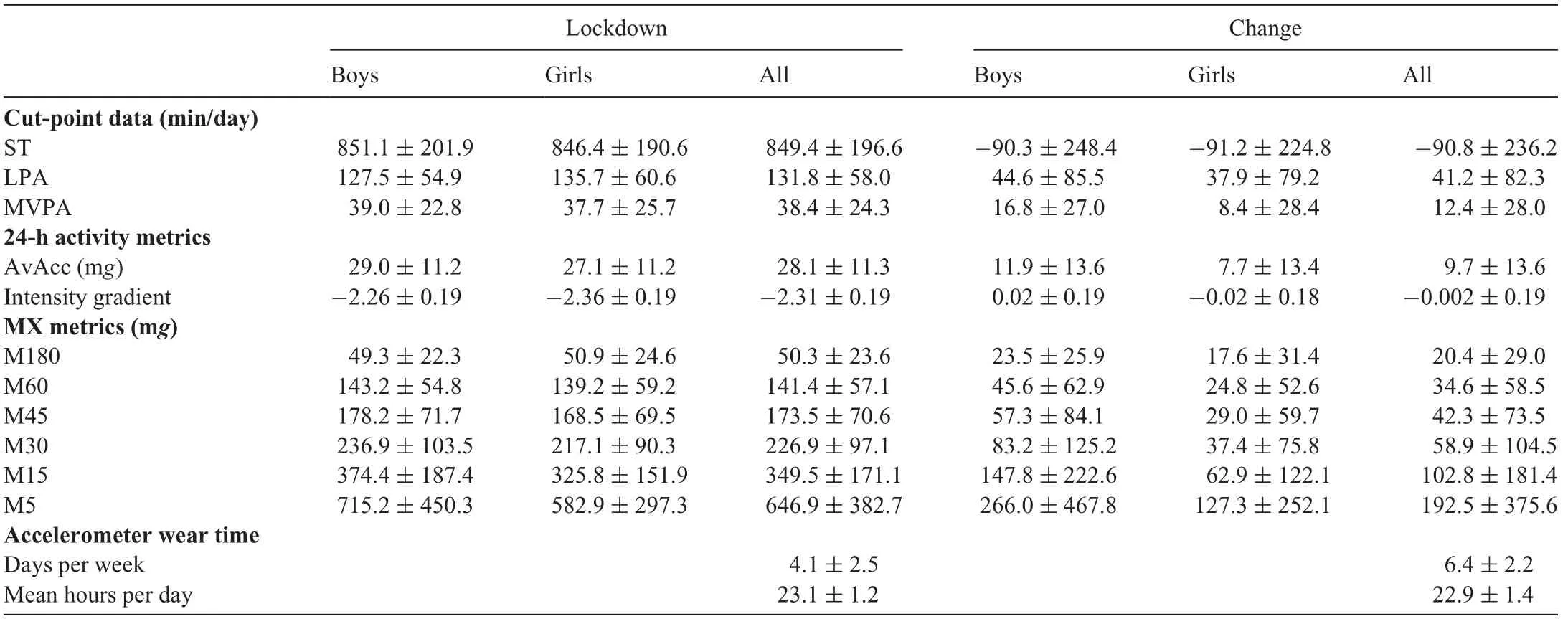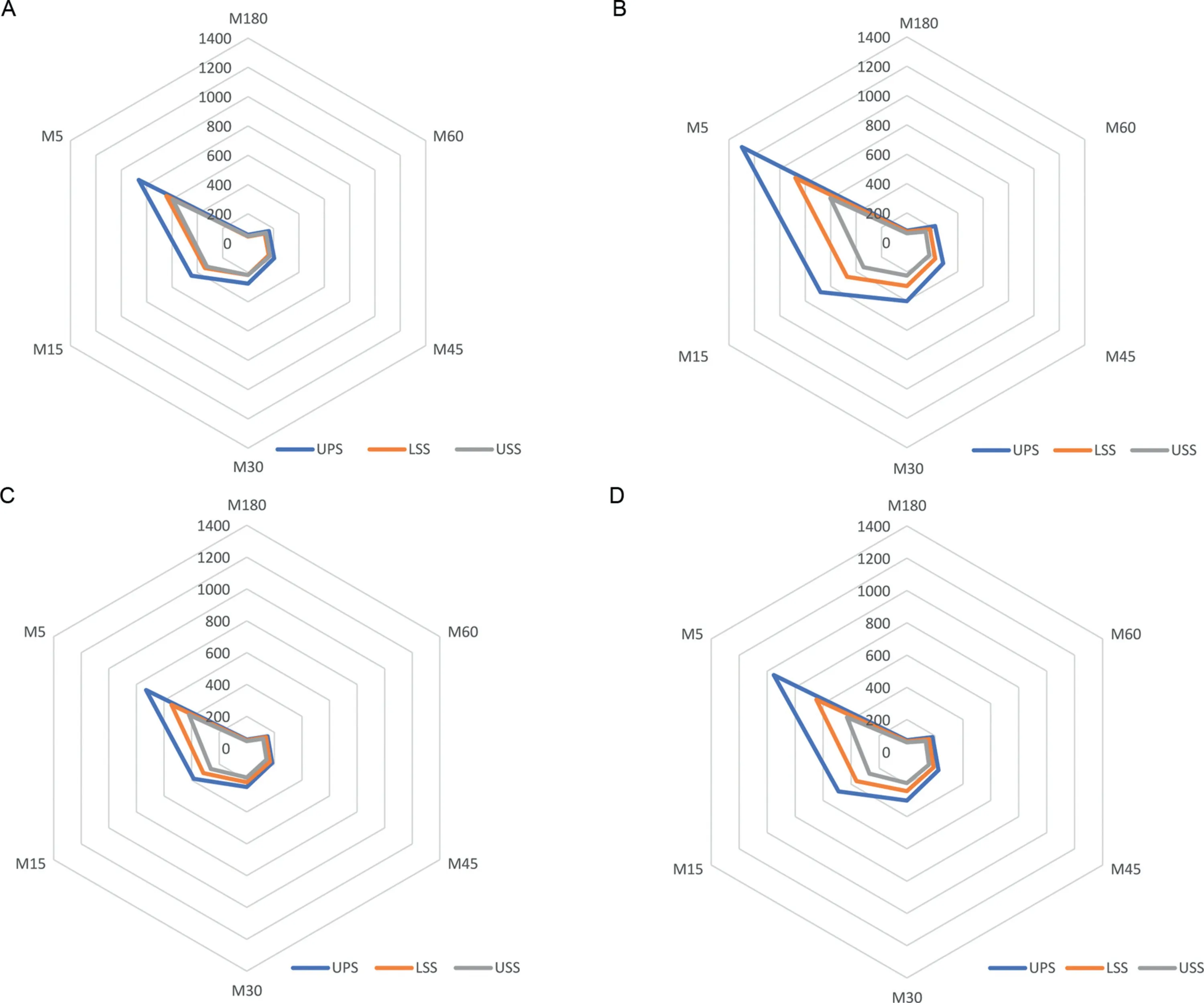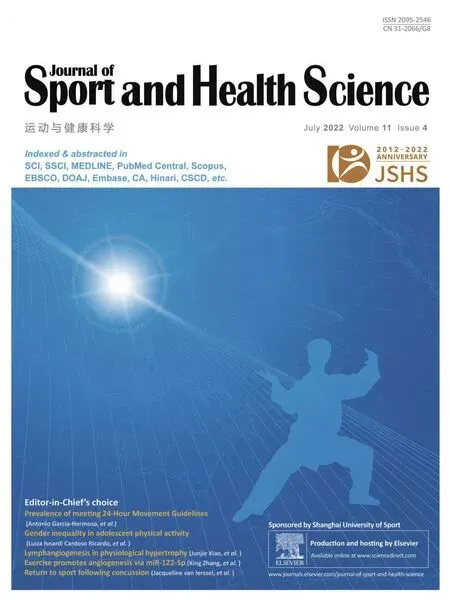Back to school after lockdown:The effect of COVID-19 restrictions on children’s device-based physical activity metrics
Liezel Hurter,Melitta McNarry,Gareth Stratton,Kelly Mackintosh
Applied Sports,Technology,Exercise and Medicine Research Centre(A-STEM),Swansea University,Swansea SA18EN,UK
Abstract Background: The coronavirus disease-2019(COVID-19)pandemic and national lockdowns took away opportunities for children to be physically active.This study aimed to determine the effect of the COVID-19 lockdown on accelerometer-assessed physical activity(PA)in children in Wales.Methods:Eight hundred participants(8-18 years old),stratified by sex,age,and socio-economic status,wore Axivity AX3 accelerometers for 7 days in February 2021,during the lockdown,and in May 2021,while in school.Raw accelerometer data were processed in R-package GGIR,and cut-point data, average acceleration (AvAcc), intensity gradient, and the acceleration above which the most active X minutes are accumulated (MX) metrics were extracted. Linear mixed models were used to assess the influence of time-point, sex, age, and socioeconomic status(SES)on PA.Results: During lockdown, moderate-to-vigorous PA was 38.4 ± 24.3 min/day; sedentary time was 849.4 ± 196.6 min/day; mean ± SD. PA levels increased significantly upon return to school(all variables p <0.001).While there were no sex differences during lockdown(p=0.233),girls engaged in significantly less moderate-to-vigorous PA than boys once back in school (p <0.001).Furthermore, boys had more favorable intensity profiles than girls(intensity gradient:p <0.001),regardless of time-point.PA levels decreased with age at both time-points;upper secondary school girls were the least active group,with an average M30 of 195.2 mg(while in school).Conclusion:The lockdown affected boys more than girls,as reflected by the disappearance of the typical sex difference in PA levels during lockdown,although these were re-established on return to school.Upper secondary school(especially girls)might need specific COVID-recovery intervention.
Keywords: Accelerometer;Intensity gradient;MX metrics
1. Introduction
The coronavirus disease-2019 (COVID-19) has caused unprecedented disruption to the lifestyles of children and adolescents. Worldwide, governments imposed COVID-19 restrictions(lockdowns)on their citizens in an attempt to slow the spread of the virus. Wales, a devolved nation within the United Kingdom (UK), enforced several national lockdowns throughout the course of the pandemic.The closure of schools,sport clubs, and indoor fitness centers, including swimming pools,resulted in the removal of the primary sources of structure, routine, and physical activity (PA) for children and adolescents. Moreover, with lockdown rules prohibiting people from gathering,even in open spaces,all organized recreational activities ceased.Indeed,during the national lockdown,people in Wales were only allowed to leave their homes for essential reasons,which included food shopping,medical needs,traveling for essential work, and exercise, with senior government ministers and medics promoting 30 min of daily exercise.
Numerous studies have sought to document the effect of various COVID-19 restrictions on children’s PA levels, with most studies included in recent systematic and scoping reviews1,2reporting a decline in the PA levels of children and adolescents. Specifically, Medrano et al.3found that selfreported PA levels in 113 Spanish children(aged 8-16 years)declined by 91 min/day,while 36%of the parents of 211 children (aged 5-13 years) living in the United States reported their children had “done much less PA” compared with pre-pandemic levels.4Similarly, 31% of parents from a largescale study (n=16,177) in New South Wales, Australia reported that their children’s PA levels had decreased “a lot”during COVID-19.5However, to date, studies during the pandemic have relied on validated3,6,7or unvalidated online questionnaires.8Although self- and proxy-report measures enable large sample sizes and ease of administration while participants are confined to their homes, they are inherently associated with numerous disadvantages,including but not limited to recall errors (especially in children)9and social desirability.10It is therefore recommended that, ideally, such methods be used in combination with device-based measures, such as accelerometry.11
No previous studies have quantified the change in accelerometer-derived PA in children and adolescents during and after COVID-19 lockdowns. However, it is imperative that device-based data are not only used, but that the results are meaningful, interpretable, and comparable12in order to accurately inform strategies aiming to alleviate the impact of COVID-19. Over the last decade, significant advances have been made in accelerometer data-processing,with the field initially progressing from the traditionally used, device-specific,counts-based cut-point method, which was reliant on proprietary algorithms, to processing raw acceleration signals that enable inter-device and -study comparability.13,14Raw acceleration signal processing allows researchers to report not only time spent in different intensities (using raw acceleration cutpoints15,16),but also newly developed accelerometer metrics that,unlike cut-points, are not population- or protocol-specific.12,17,18The latter produce results that are easily comparable with maximal potential for data harmonization.19Therefore,the aim of this study was to determine the effects of the third national COVID-19 lockdown on a range of PA metrics using raw acceleration data in children and adolescents in Wales.
2. Methods
2.1. Participants and procedures

Fig.1. Flow diagram of participants and files included in each stage of the analysis.SES=socioeconomic status.
After gaining approval from Swansea University’s Research Ethics Committee(reference number:KM_04-08-20b),800 participants,stratified by sex,age,and socioeconomic status(SES),were randomly selected, from 1708 children and adolescents who completed an online survey and whose parents completed a parental consent form,to wear an Axivity AX3 tri-axial accelerometer (Axivity Ltd, Newcastle, UK). The whole study took place remotely, with accelerometers and instructions mailed to participants. The first data collection time-point took place in January and February 2021 during the third national lockdown,which started on December 19,2020 and continued until March 12, 2021. During this time-point, schools offered online learning,with the exception of vulnerable children or children of key workers,who were allowed to attend school in person.The second data collection time-point took place at the end of April and beginning of May 2021,shortly after the Easter break and while all children were back in school. Organized sport for children had resumed,and indoor swimming pools had reopened.Again,800 Axivity monitors were mailed to participants.Of these,734 had also participated during the lockdown time-point,while the rest were new recruits(66 participants from the first time-point either declined to wear a monitor for the second time-point,or their first device was not returned).Fig.1 shows the number of participants included in each phase of the study and analysis.
Accelerometers were initialized to start recording data 2 working days after postal dispatch,at a sampling frequency of 100 Hz. Participants were asked to start wearing the monitors immediately on receipt and to then wear the device continuously for 7 consecutive days on the non-dominant wrist.Devices were subsequently returned in a pre-paid envelope.
2.2. Data processing and analyses
Accelerometer data were downloaded with OmGui opensource software (OmGui Version 1.0.0.43; Open Movement,Newcastle, UK), saved in .cwa format, and processed using R-package GGIR (Version 2.3-0; https://cran.r-project.org).20Signal processing in GGIR includes autocalibration using gravity as a reference21and the detection of non-wear.Specifically,the default non-wear setting was used, whereby GGIR imputes non-wear data utilizing the average at similar time-points on other days of the week.GGIR also calculated the magnitude of dynamic acceleration corrected for gravity (Euclidean Norm minus 1 g), averaged over 1-s epochs, and expressed in milligravitational units(mg).For their data to be included in the raw analysis, participants needed to log at least 16 h of wear-time per day.13GGIR was used to report raw acceleration cut-point data, including sedentary time (ST; defined as waking time accumulated below the 50 mg threshold),15light PA(LPA),and moderate-to-vigorous PA(MVPA;defined as time accumulated above 191.6 mg),22all obtained from GGIR output Part 5.While these cut-points were developed using GENEActiv devices, the GENEActiv and Axivity accelerometers have shown excellent equivalence and agreement across most raw data outcome measures.13,23Furthermore,average acceleration(AvAcc;mg),intensity gradient(IG),and the acceleration above which a person’s most active 180,60,45,30,15,and 5 min were accumulated(MX metrics;mg),are reported from GGIR output Part 2. The AvAcc is a direct measure of dynamic acceleration and is used as a single metric for the overall activity averaged per day.19The IG reflects the distribution of acceleration intensity across the 24-h day by plotting the natural logs of time accumulated against acceleration intensity, resulting in a straight-line(negative slope) graph. A steeper, more negative gradient reflects a poorer intensity profile, with the person spending more time in the low- to mid-range intensities, whereas a shallow,less negative(higher)gradient means more time was spent in higher intensities, thus reflecting a more favorable intensity profile.17The MX metrics allow for post hoc translation ofaccelerometer metrics, meaning that researchers can apply any cut-point or acceleration associated with a specific activity to the dataset.24The latter facilitates easily interpretable public health messages. For example, acceleration intensities ranging from 100-200 mg are indicative of a slow walk;>200-350 mg,a brisk walk; >350-500 mg, fast walking or jogging; while>500-1000 mg indicates slow running; >1000-1500 mg,medium running; >1500-2000 mg, fast running, and >2000 mg,sprinting or jumping.25
Descriptive statistics (means ± SD) by age group, sex, and SES were calculated for all variables. Participants were divided into 3 age groups, according to school year: (a) Years 4-6(n=300; girls=150; 9.9 ± 0.9 years), called “upper primary school” (UPS); (b) Years 7-9 (n=292; girls=149; 12.9 ± 0.9 years), called “lower secondary school” (LSS); and (c) Years 10-13(n=208;girls=115;15.6±0.9 years),called“upper secondary school” (USS). To gain a measure of SES, the Welsh Index of Multiple Deprivation26was used to divide participants into quintiles.Quintiles were ranked from 1 to 5,representing the most-and least-deprived group,respectively.
Linear mixed models were conducted separately for each PA metric to investigate the differences between lockdown and school data and to assess the influence of time-point, sex,age group, and SES, along with their interaction, on PA metrics, with planned contrasts used to further explore significant interaction effects. Results are reported as beta coefficients(β),95%confidence intervals(95%CIs)or standard error(SE),and p values,with level of significance set as p <0.05.Sensitivity analyses were run by repeating the same analyses 3 times but varying the inclusion criteria from at least 3 valid days to 2 and, finally, at least 1 valid day. Statistical significance remained the same after relaxing the inclusion criteria; therefore, it was decided to use at least 1 valid day’s data,in order to include more participants,thus adding power to the analyses and reducing bias.27Analysis was conducted in STATA MP(Version 13;StataCorp.,College Station,TX,USA).
3. Results
All PA variables increased significantly once children returned to school after lockdown(all p <0.001;Table 1 and Supplementary Table 1).Time spent in MVPA during lockdown was 38.4±24.3 min/day, while ST according to the 50 mg cut-point was 849.4± 196.6 min/day(Table 1).MVPA increased significantly upon return to school (β=20.6, 95%CI: 15.4-25.7; p <0.001;Supplementary Table 1),with a corresponding significant decrease in ST(β=-73.1,95%CI:-116.4 to-29.8;p=0.001).Planned contrasts to explore the significant interaction effect of time-point and sex on MVPA (p=0.036)revealed that while there were no sex differences during lockdown(p=0.233),MVPA significantly increased in both sexes on return to school(both p <0.001),with girls engaging in significantly less MVPA than boys once in school(p <0.001).While there were also no significant sex differences in LPA, ST, and M180, regardless of time-point, boys’intensity profiles (IG) and AvAcc per day were significantly higher in comparison to girls during both time-points (planned contrasts of boys vs. girls at both time-points: all p <0.001, except for AvAcc during lockdown: p=0.005). Furthermore, sex differences were manifest as the duration of the most active minutes decreased,with boys demonstrating a higher M30, M15, and M5 relative to girls during lockdown (Table 1)and a greater increase in these variables upon return to school.For example, during lockdown, boys’ M15 was 374.4 mg while that of girls was 325.8 mg. Using the activity intensities mentioned earlier,this means that boys’most active 15 min of the day were spent in accelerations equivalent to fast walking or jogging,while girls’ most active 15 min were equivalent to a brisk walk.These differences are also evident in the significant time-point and sex interaction effect on the lower MX variables(all p <0.001).

Table 1 Change in all variables between lockdown and return to school from participants with data at both timepoints(mean±SD).
Upon return to school, 50.8% of UPS children met the UK government MVPA guidelines of 60 min/day,28while only 28.8% of LSS and 11% of USS pupils achieved the government guidelines.LPA showed a substantial increase on returning to school for those in USS (~30 min; Supplementary Table 2). Results from linear mixed models revealed significant main effects of age group for almost all variables, with PA consistently decreasing with age,regardless of time-point.Planned contrasts exploring the significant time-point×age group interaction effect revealed that MVPA increased significantly upon return to school in UPS and LSS children (both p <0.001) but not USS (p=0.109). The IG of UPS children was significantly higher upon their return to school (β=0.06;SE=0.01;p <0.001),but for USS pupils,returning to school decreased their IG significantly (β=-0.08; SE=0.01;p < 0.001), while LSS children showed no difference(p=0.721). The lower MX variables (M30 to M5) all showed significant interaction effects of time-point×age group.However,further planned contrasts revealed that M15 and M5 values increased significantly in UPS and LSS children (all p <0.001)but not USS(M15:p=0.091;M5:p=0.547).
Differences between age groups across time-points for both sexes are further illustrated with radar plots(Fig.2)and Supplementary Table 3. Across the intensity spectrum, UPS children,irrespective of sex or time-point, had consistently higher values than those in LSS and USS.For boys during lockdown,the biggest drop in MX values across the spectrum occurred between UPS and LSS (Fig. 2A). Upon return to school, MX values for both UPS and LSS increased, as is particularly evident in the greater surface areas covered around the lower MX variables(Fig.2B).The decrease in MX values for girls in lockdown from UPS to LSS continues noticeably to USS(Fig.2C),while as with boys,girls in USS barely showed a difference across time-points(Fig.2D).USS girls were the least active group,with an average M30 of 195.2 mg.

Fig. 2. Radar plots illustrating intra-participant differences in MX metrics by age-group and time-point, for (A) Boys during lockdown, (B) Boys on return to school,(C)Girls during lockdown,and(D)Girls on return to school.LSS=lower secondary school;UPS=upper primary school;USS=upper secondary school.
There was a significant main effect of SES on MVPA(p=0.029), with higher SES associated with increases in MVPA of 1.27 min per quintile. Similarly, SES had a significant main effect on all 24-h and MX metrics except for M180(p=0.210).
4. Discussion
The aim of this study was to determine the effect of the COVID-19 lockdown on the PA levels and intensities of children and adolescents using various accelerometer metrics.Overall, PA levels increased significantly upon return to school, with widening differences between girls and boys and a significant decline in PA with age.
The PA levels during lockdown were low in comparison to values reported pre-COVID-19.29These findings are not surprising given that COVID-19 restrictions removed many opportunities for children and adolescents to be active,such as sport clubs, active travel to school, and school break times. It is also pertinent to note that the results are in accord with selfreported levels during lockdown periods.1However,the extent of the effect of lockdown on the PA levels of children and adolescents was,perhaps,greater than expected.While it could be postulated that the low PA levels are a result of the cut-points utilized being developed in 7-11-year-olds22and 9-10-yearolds,15and so therefore not encompassing the full age range of the present sample, this is unlikely given that the MX metrics were congruent across all age groups. During lockdown, children and adolescents did not reach intensities indicative of a brisk walk(200 mg)for 45 min/day.25
Contrary to research conducted pre-COVID-19,30,31there were no significant sex differences in MVPA according to applied cut-points. Previous research has shown that extracurricular sport participation is higher in boys than in girls,32which might explain this finding as lockdown rules prohibited all organized sport participation. Elnaggar et al.33also reported a more prominent drop in the PA levels of boys as compared to girls during social distancing measures while organized sport was banned.However,IG results revealed that boys still had more favorable intensity profiles,which are associated with health indicators such as obesity, metabolic risk,and cardiorespiratory fitness.14The higher IG found in boys during lockdown was driven by the low duration MX metrics,with boys achieving significantly higher intensities during their most active 15 and 5 min of the day compared to girls.Of interest, the previously reported sex differences in MVPA30were re-established upon return to school, suggesting that the sociocultural environment at school may be more conducive for boys to be physically active than for girls. Of particular concern are the PA levels and intensities of USS girls,who,on average,failed to reach 30 min of accelerations(M30)equivalent to a brisk walk(200 mg),25even upon return to school.
Once back in school,half of UPS children met the government guidelines of at least 60 min of MVPA per day across the week,28while almost 80%of those in secondary school still failed to reach MVPA guidelines. Specifically, USS participants barely showed an increase in MVPA(+3 min/day),and their IG decreased.The latter could be attributed to the second time-point being aligned with upcoming examinations,during which time participants may have spent more time studying.The relative increase observed in LPA between time-points for both LSS and USS groups could be attributed to active travel to and from school.However,the larger increase in all PA variables upon returning to school for UPS children suggests that younger children were more affected by the COVID-19 restrictions than older children. This is perhaps expected given that younger children are less likely to go out independently;thus,they rely on parents or care-takers to accompany them34and/or utilize school break times to be more active.35
This study has several strengths.It is the first study to utilize device-based PA assessment in children and adolescents during a COVID-19 lockdown. Furthermore, repeating data collection at a second time-point enabled intra-participant comparisons across different stages of the COVID-19 pandemic, which, combined with the use of various accele-rometer metrics,resulted in new insights into the differences of PA between boys and girls. The wide age range of participants included in the study facilitated primary and secondary school comparisons, in which there were stark differences. The sample size was large and country-specific, with participants stratified by age, sex, and SES, and thus provided a dataset demographically representative of children and adolescents in Wales. Nonetheless, the study is not without limitations.Indeed,the initial lockdown period took place in winter,which has been shown to be associated with lower PA levels in youth populations.36Given that USS adolescents, particularly girls,demonstrated such undesirable PA profiles upon return to school, despite the lifting of COVID-19 restrictions and data being collected in springtime, the importance of this finding cannot be overstated.Furthermore,the use of accelerometry to examine movement behaviors in isolation,without any contextual information,limits the conclusions that can be drawn.
5. Conclusion
Using a range of accelerometer metrics,this study provides results quantifying the effect that the COVID-19 lockdown has had on PA in children and adolescents.PA levels in boys were more negatively affected by the lockdown than those of girls,though there were significant differences in the PA profiles,irrespective of sex, during both time-points. While PA levels of UPS children and younger boys increased immediately upon return to school, similar COVID-recovery behavior was not evident in USS.Given the low,and indeed decreased,levels of PA in USS pupils(especially girls),future interventions should seek to specifically target this age group.
Acknowledgments
The authors thank all the children who took part in this study as well as their parents, who provided consent. This research was funded by the Welsh Government S^er Cymru III Tackling COVID-19 grant scheme(Welsh Government project number: 099), The Higher Education Funding Council for Wales Research Wales Innovation Fund (Collaboration Booster Faculty Fund), and the Swansea University Greatest Need fund. LH was partly funded by The Welsh Institute of Physical Activity,Health and Sport.
Authors’contributions
KM conceived and designed the study,assisted with data collection, and provided critical feedback on the manuscript; MM conceived and designed the study, assisted with data collection, conducted the statistical analysis, and provided critical feedback on the manuscript; GS conceived and designed the study and provided critical feedback on the manuscript; LH collected, processed, and analyzed the data,and wrote the first draft.All authors read and approved the final draft of the manuscript,and agree with the order of presentation of the authors.
Competing interests
The authors declare that they have no competing interests.
Supplementary materials
Supplementary materials associated with this article can be found in the online version at doi:10.1016/j.jshs.2022.01.009.
 Journal of Sport and Health Science2022年4期
Journal of Sport and Health Science2022年4期
- Journal of Sport and Health Science的其它文章
- What is driving gender inequalities in physical activity among adolescents?
- Lymphangiogenesis:A new player in the heart’s adaptive response to exercise
- Exercise regulates cardiac metabolism:Sex does matter
- Engagement in outdoor physical activity under ambient fine particulate matter pollution:A risk-benefit analysis
- Associations between meeting 24-hour movement guidelines and academic achievement in Australian primary school-aged children
- Gender inequalities in physical activity among adolescents from 64 Global South countries
